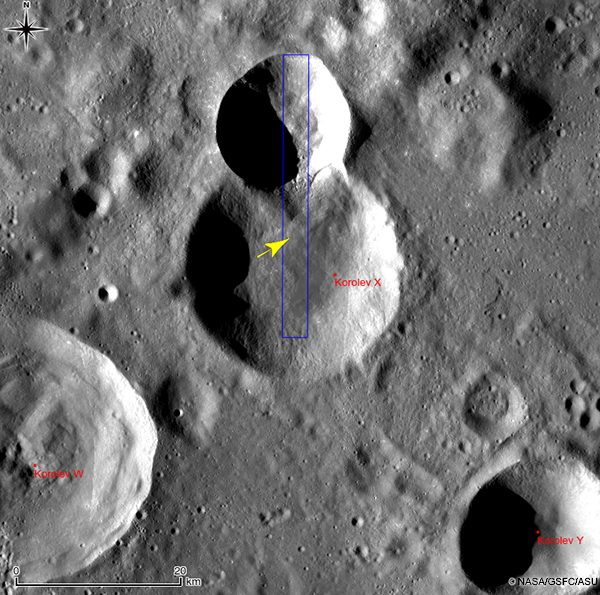Quick Views of Big Advances
Lava Flow Look-a-Likes
Impact melt flows on the Moon are formed by the high pressures of shock and melting of rock during an impact event. Once solidified they look like lava flows even though the formation processes are different. The two types of flows can share common features, such as sinuous channels and lobe shapes, because of their molten history. Finding and studying an analogue on Earth would be valuable for understanding the surface properties of lunar impact melt flows, which may someday be visited and sampled for further study. With that goal, scientists compared the surface roughness characteristics of an impact melt flow on the lunar farside with lava flows on Earth.
 |
This Lunar Reconnaissance Orbiter –Wide Angle Camera monochrome mosaic shows the farside crater Korolev X (diameter of 25 kilometers) and its surrounding area. Yellow arrow points to low-albedo, smooth-looking impact melt flow. Image resolution is 100 meters per pixel. Click the image for more information. |
The team conducted fieldwork and created beautifully detailed topographic profiles and radar roughness maps of lava flows in Hawai‘i, Idaho (Craters of the Moon National Monument and Preserve), and Iceland (Holuhraun in Vatnajökull National Park).
The closest Earth analogue they identified is a rubbly lava flow at Holuhraun. However, even this candidate does not have the same small-scale roughness and large-scale smoothness that characterize the lunar impact melt flow. Neish and coauthors suggest the lack of similarities between terrestrial lava flows and the lunar impact melt flow can be attributed to differences (1) in data resolution and processing or (2) in the natural processes that modified the flows after emplacement, including blanketing by regolith or (3) in initial surface textures simply because a cooling impact melt may be a fundamentally different process from a cooling lava flow.
Researchers will continue to look at details of surface roughness from orbital and surface perspectives in their quest to understand the geologic processes that create planetary surfaces.
![]() (pdf version)
(pdf version)
See Reference:
· Neish, C. D., Hamilton, C. W., Hughes, S. S., Kobs Nawotniak, S., Garry, W. B., Skok, J. R., Elphic, R. C., Schaefer, E., Carter, L. M., Bandfield, J. L., Osinski, G. R., Lim, D., and Heldmann, J. L. (2017) Terrestrial Analogues for Lunar Impact Melt Flows, Icarus, v. 281, p. 73-89, doi: 10.1016/j.icarus.2016.08.008. [ abstract ]
See also:
· Stopar, J. D. (2014) Impact Melt Flow, Encyclopedia of Planetary Landforms, p. 1-9, Springer New York, doi: 10.1007/978-1-4614-9213-9_503-1. [ abstract ]
Written by Linda M. V. Martel, Hawai‘i Institute of Geophysics and Planetology, for PSRD.
|
|
[ About PSRD | Archive | CosmoSparks | Search | Subscribe ] [ Glossary | General Resources | Comments | Top of page ] |
|
January 2017
|
